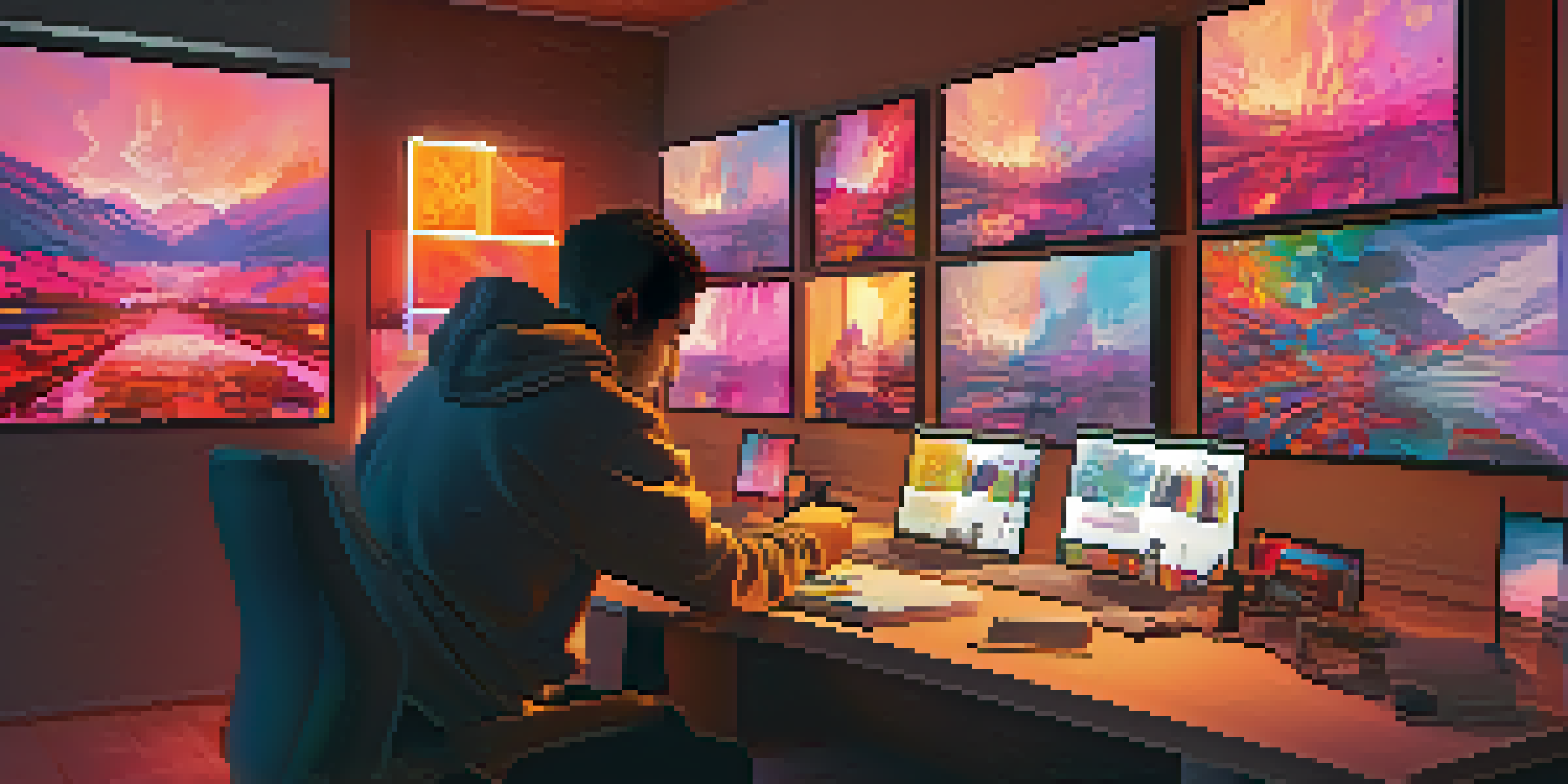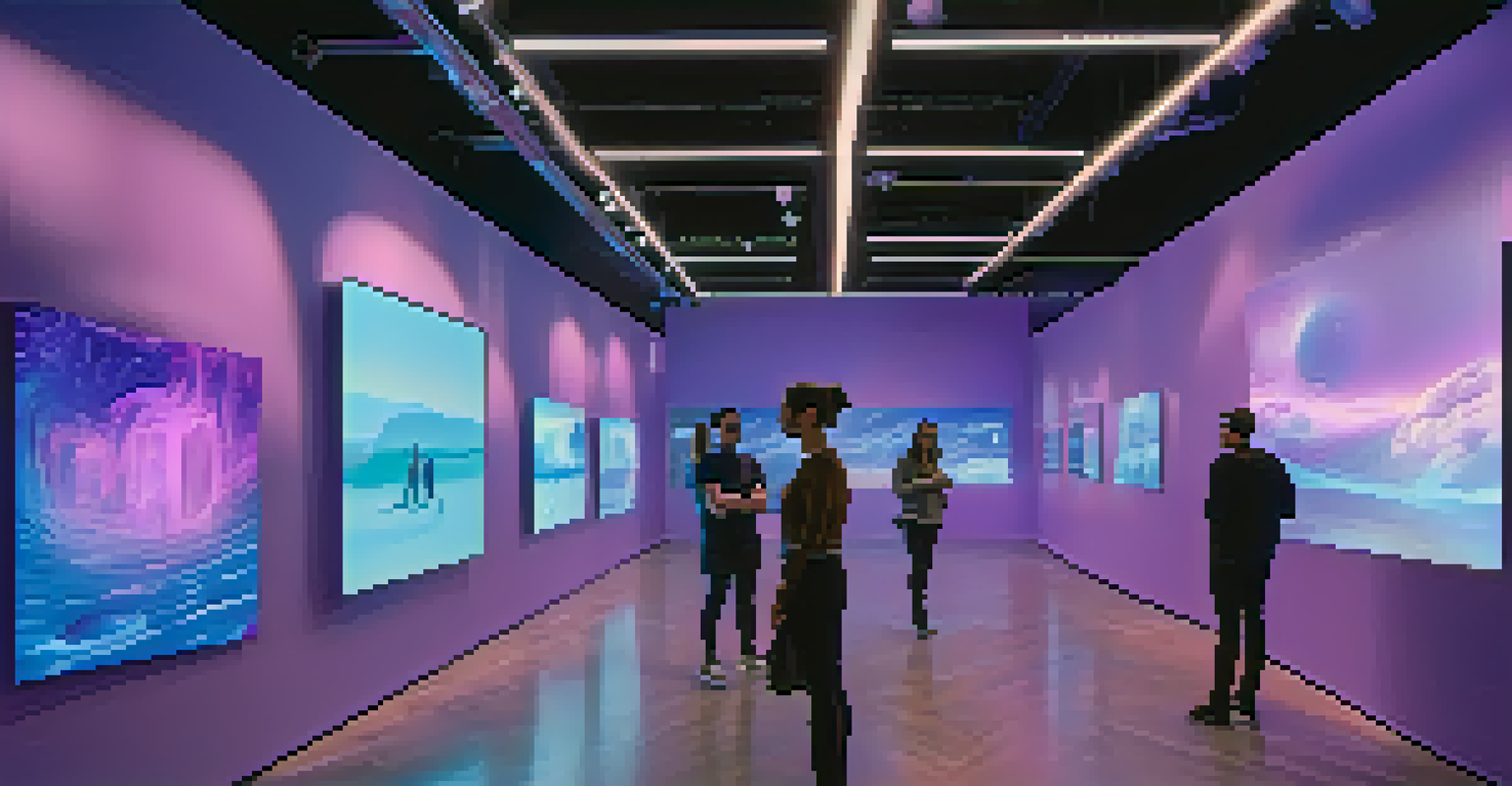NFTs and Ownership: Redefining Economic Models in Digital Assets

Understanding NFTs: A New Era of Digital Ownership
Non-Fungible Tokens, or NFTs, represent a groundbreaking shift in how we perceive ownership in the digital realm. Unlike cryptocurrencies like Bitcoin, which are interchangeable, NFTs are unique digital assets that can represent anything from art to virtual real estate. This uniqueness allows creators and collectors to establish verifiable ownership of digital items, opening up new avenues for monetization and trade.
Digital ownership is the new frontier of creativity and commerce.
Imagine owning a one-of-a-kind piece of digital art, complete with a certificate of authenticity stored on the blockchain. This transformation is akin to owning an original painting rather than a print; the value lies in its uniqueness and provenance. As more artists and creators embrace NFTs, the market for digital assets is rapidly expanding, creating fresh opportunities for both creators and collectors.
However, this new model doesn't come without challenges. Questions about copyright, ownership rights, and market regulation are still forming as the landscape evolves. Nevertheless, NFTs are undeniably reshaping our understanding of ownership in the digital age, prompting us to rethink traditional economic models.
The Technology Behind NFTs: Blockchain Simplified
At the heart of NFTs lies blockchain technology, which serves as a decentralized ledger that records transactions securely. This technology ensures that the ownership and transaction history of an NFT is transparent and tamper-proof, giving buyers confidence in their investments. Think of it as a public library where everyone can see who has checked out a book, but no one can alter the records.

Blockchain's ability to create a unique identifier for each digital asset means that NFTs can’t be duplicated in a meaningful way. This uniqueness is what differentiates NFTs from other digital files, which can be copied endlessly. In essence, owning an NFT is akin to having the only key to a digital vault, while others may have copies of the contents inside.
NFTs Redefine Digital Ownership
NFTs enable creators to establish verifiable ownership of unique digital assets, transforming how we perceive ownership in the digital realm.
By leveraging blockchain, NFTs also empower creators with more control over their work. Artists can embed smart contracts that automatically pay them royalties every time their NFT is resold, ensuring they benefit from their creations long after the initial sale. This shift not only enhances revenue for artists but also fosters a more sustainable creative economy.
NFTs and the Creative Economy: Empowering Artists
NFTs have fundamentally altered the landscape for artists and creators, offering them new ways to monetize their work directly. In the past, artists often relied on galleries or agents to sell their art, taking a significant cut of their earnings. With NFTs, artists can sell their pieces directly to collectors, significantly increasing their profit margins.
NFTs are not just a trend; they are a fundamental shift in how we understand ownership and value in the digital age.
For instance, consider a digital artist who creates a vibrant digital painting. By minting it as an NFT, they can not only sell it to collectors but also ensure they receive a percentage of any future sales through smart contracts. This creates a sustainable income model for artists, allowing them to thrive in a competitive market.
Moreover, the NFT market is diverse, encompassing everything from music to virtual fashion. This diversity empowers artists across various mediums to find their niche, connect with audiences directly, and build their brands without intermediaries. As a result, NFTs are democratizing the creative economy, allowing more voices to be heard.
Consumer Behavior: How NFTs Change Art Collecting
The rise of NFTs has also transformed how consumers approach art collecting. No longer are collectors limited to physical galleries; they can now explore vast online marketplaces filled with unique digital assets. This shift has broadened the appeal of art collecting, making it more accessible to a global audience.
Imagine a collector in New York who can now bid on a digital sculpture created by an artist in Tokyo, all from the comfort of their home. This global reach means that art can be appreciated and purchased by anyone, regardless of location, creating a more diverse and engaged community of collectors. It’s a bit like having a virtual gallery that never closes.
Blockchain Empowers Creators
Blockchain technology ensures transparency and allows artists to earn royalties through smart contracts, fostering a more sustainable creative economy.
Additionally, the appeal of owning a unique digital item—often accompanied by community status—has attracted a new generation of collectors. Many see NFTs as a status symbol, akin to owning a rare physical artwork. This change in consumer behavior is driving demand for NFTs, further fueling their growth in the market.
Challenges in the NFT Market: Risks and Considerations
Despite the excitement surrounding NFTs, there are notable challenges and risks that both creators and collectors need to navigate. One major concern is the environmental impact of blockchain technology, particularly those that rely on energy-intensive proof-of-work systems. As awareness grows, many advocate for more sustainable practices in NFT creation and trading.
Another challenge is the volatility of the NFT market, which can be prone to rapid price fluctuations. Just as the stock market can experience sudden downturns, NFT prices can swing dramatically, leaving buyers at risk of significant losses. This uncertainty can deter potential collectors from entering the market, highlighting the importance of thorough research before investing.
Additionally, issues related to copyright and ownership rights are still developing. As the market matures, legal frameworks will need to evolve to protect creators and buyers alike. Until then, it’s crucial for participants in the NFT space to remain informed and cautious to safeguard their investments.
The Future of NFTs: Trends to Watch
Looking ahead, the future of NFTs appears bright, with several trends poised to shape their trajectory. One notable trend is the increasing integration of NFTs into gaming, where players can buy, sell, and trade in-game assets as unique tokens. This shift is revolutionizing how players interact with virtual worlds and creating new economic models within the gaming industry.
Additionally, the concept of fractional ownership is gaining traction, allowing multiple investors to own shares of high-value NFTs. This democratizes access to premium digital assets, making it possible for more people to participate in the NFT market without needing vast sums of money. It’s similar to owning a piece of a luxury property rather than the entire estate.
NFTs Change Art Collecting Dynamics
The rise of NFTs has expanded art collecting to global online marketplaces, making it more accessible and appealing to a diverse audience.
Moreover, as more industries explore the potential of NFTs, we may witness their adoption in sectors like real estate, music, and sports. This cross-industry integration will likely lead to innovative applications and use cases, solidifying NFTs' place in the digital economy. The exciting possibilities suggest that we are only scratching the surface of what NFTs can achieve.
Conclusion: Embracing the NFT Revolution
In conclusion, NFTs are not just a passing trend; they represent a fundamental shift in how we understand ownership and value in the digital age. By empowering creators and transforming consumer behavior, NFTs are redefining economic models across various industries. As we navigate this rapidly changing landscape, it’s essential to remain informed and adaptable.
The challenges associated with NFTs, from environmental concerns to market volatility, will undoubtedly require ongoing attention and innovative solutions. However, the potential benefits—such as increased income for artists and broader access to art—are compelling reasons to embrace this new frontier.

As we continue to explore the possibilities of NFTs, one thing is clear: they are here to stay, reshaping our interactions with digital assets and paving the way for a more inclusive and dynamic creative economy.